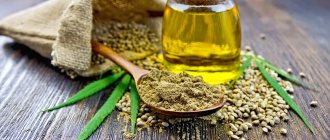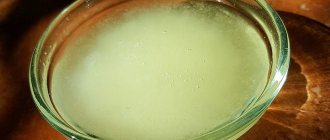The source of linseed oil is flax seeds, a plant that is cultivated annually and is of great economic importance.
Flaxseeds consist of 30-40% fatty oil. The cold pressing procedure ensures that 18-20% of the oil is obtained from the original raw material. Seeds that have undergone cold processing (meal) are hot pressed, yielding another 5-7% of oil, the scope of which will be only for technical needs.
But cold-pressed products are actively used as:
- dietary element;
- in pharmaceutical production - as raw materials for the production of dietary supplements and a liquid medium in which the active ingredients of medications are diluted;
- component of paint and varnish products on a natural basis;
- binder for environmentally friendly polymer materials.
Unrefined flaxseed oil, yellowish in color, has a special aroma and a unique, slightly bitter taste.
Composition and calorie content
Calories 884 Kcal
- Fat:
99.8 g - Proteins:
0.1 g - Carbohydrates:
0.0 g - Water:
0.1 g - Ash:
0.0 g
| Fats (per 100 g): | Quantity | %RDN |
| Omega-3 | 53.4 g | 5335% |
| Omega-6 | 12.7-14.3 g | 135% |
| Omega-9 | 18.3-20.2 g | — |
| Saturated fatty acids | 9.0-9.9 mcg | 38% |
1.9 g of flaxseed oil (less than half a teaspoon) fully satisfies the daily requirement of the human body for alpha-linolenic acid (ALA).
| Phytosterols (per 100 g): | Quantity | %RDN |
| Total phytosterols | 689 mg | 1252% |
| Beta-sitosterol | 206 mg | 515% |
| Campesterol | 98-105 mg | 184% |
| Delta-5-avenasterol | 59 mg | 107% |
| Stigmasterol | 30-35 mg | 93% |
Full chemical composition ➤
Useful action
Vitamins and essential fatty acids in flaxseed oil help in the treatment of:
- cancer;
- prostate disorders;
- Alzheimer's disease;
- multiple sclerosis;
- rheumatic diseases;
- allergies;
- disorders of the circulatory system (atherosclerosis, myocardial infarction, arrhythmia)
- diseases of old age;
- visual and hearing defects;
- memory problems (activation of brain function);
- any dermatological problems;
- digestive problems: hepatosis, gallbladder disease, stomach ulcers
- diabetes
Benefits of flaxseed oil
By taking this remedy, which is useful in all respects, you can improve your health, normalize fat metabolism, and prevent cardiovascular diseases, pathologies of the digestive system and metabolic processes.
Beneficial properties of flaxseed oil:
- Increases the elasticity of blood vessels, reduces the likelihood of stroke and heart attack, hypertension;
- Serves to prevent atherosclerosis and thrombosis;
- Normalizes fat metabolism, promotes weight loss;
- Improves the functioning of the digestive tract;
- Acts as a prophylactic against the formation of gallstones, normalizes the functioning of the biliary system;
- Increases immunity;
- It is a good source of omega-3 polyunsaturated fatty acids for vegetarians.
You should not use flaxseed oil for self-medication and at the same time cancel medications prescribed by your doctor. Before using the oil, you should consult a qualified specialist in the profile of your disease and take into account all contraindications.
Omega-3 in flaxseed oil
Flaxseed oil is the champion in omega-3 content, second only to fish oil. The concentration of omega-3 fatty acids in flaxseed oil reaches, according to various sources, from 44% to 60%.
These beneficial lipids enter the body through the small intestine after pre-treatment with bile enzymes in the duodenum. A certain amount of omega-3 enters the liver, where it becomes a full-fledged participant in metabolic processes. A tablespoon of flaxseed oil contains up to 8 grams of omega-3 fatty acids, while the remaining acids, omega-6 and omega-9, are represented by 2 and 3 grams, respectively.
The founder of the Gerson Institute from California, Charlotte Gerson, published the results of scientific research she organized, according to which flaxseed oil is not only a leading donor of beneficial lipids, but also slows down the growth of tumor cells.
It should be noted that despite the fact that omega-3 from flaxseed oil consists of 100% ALA fatty acid, and does not contain the most beneficial EPA and DHA, taking 1-3 tablespoons per day, you still get enough many benefits (what is the difference between omega-3 from flaxseed oil and omega-3 from fish oil? ➤).
Enriching the diet with omega-3 polyunsaturated fatty acids leads to positive changes:
- Heart rate normalizes;
- Indicators of blood pressure and biochemical composition of the blood are approaching normal;
- The functioning of the glands of the endocrine system is restored;
- Metabolism is normalized, the risk of obesity and diabetes disappears;
- The level of “bad” cholesterol in the blood and the risk of blood clots are reduced;
- Blood viscosity decreases, which is very useful for the prevention of varicose veins;
- Constipation disappears;
- The condition of the skin and hair is noticeably improved;
- Hormonal levels are restored in women and men;
- Blood supply to the brain and the condition of blood vessels improves.
Experimental studies organized by Leonard Storlien, a professor at one of the Australian universities in Sydney, have shown that food enriched with omega-3 lipids helps normalize metabolism, preventing obesity and diabetes.
Weight loss
The oil helps normalize the functioning of the gastrointestinal tract, cleanses the liver and improves fat metabolism, which means that if used correctly, extra pounds will be lost without dieting. In addition, this fight against obesity will help improve the condition of your skin and hair.
You should start losing weight with flax oil by taking 1 tsp. funds per day. It should be taken before breakfast. After ten days, the dosage should be increased to 1 tablespoon. After a month, the course of treatment should be stopped after a two-week break. If necessary, the course of taking the oil is repeated.
Benefits of flaxseed oil for women
Women's health, reproductive function, beauty and well-being at all ages are areas in which flaxseed oil can provide invaluable help. Its unique composition will help strengthen the immune system, prevent diseases of the cardiovascular system, and regulate blood pressure.
During pregnancy, prerequisites for the development of varicose veins often appear due to increased stress on the body. Dosed intake of flaxseed oil will preserve the elasticity of blood vessels and reduce the risk of blood clots. Its ability to soften the skin will help avoid stretch marks on the stomach and chest. The use of this drug during the formation of the fetus will have a positive effect on the functioning of the unborn child’s brain, retina and other important organs and systems.
Women at risk of miscarriage should not abuse flaxseed oil during pregnancy, since it contains a natural analogue of estrogen, and an excess of this hormone negatively affects the course of pregnancy. But on the other hand, the natural estrogens of flaxseed oil will come in handy during menopause, when, with the attenuation of ovarian function, the body produces less and less of this femininity hormone.
Flax seed (especially in the shell of white flax) contains a record amount of phytoestrogens, but depending on the processing technology, the concentration of plant hormones in the oil can be either high or insignificant.
Replacing natural estrogen with a natural analogue will allow a woman to postpone the period of withering, keep the skin of her hands and face fresh and young, and reduce the manifestations of menopause in the form of hot flashes, dizziness, and pressure surges. For these purposes, flaxseed oil is used with caution by women with prerequisites for the appearance of cancer diseases that depend on the level of estrogen: breast and ovarian tumors.
Find out more:
list of foods with phytoestrogens
The role of this product is invaluable for maintaining the beauty of the skin of the face and hands, nails and hair. Internal use of oil, masks and applications with it to nourish the skin and nail plate will help make them smooth and beautiful, and remove fine wrinkles on the face. The need for regular use of this remedy is especially great in women who practice various diets that are not always balanced in terms of the presence of substances necessary for the body.
Even with a fairly modest diet, the body will always have enough vitamins, macro- and microelements to maintain optimal health and excellent mood, resistance to stress and increased stress.
Benefits of flaxseed oil for men
The unique composition of flaxseed oil has a general strengthening effect on the male body, which cannot but lead to a lasting increase in potency. The mechanism of its stimulation depends on increasing the elasticity of blood vessels, including the vessels of the penis. Its blood supply improves, which allows you to maintain a stable erection.
Normalizing the endocrine system of the male body with the help of flaxseed oil promotes increased production of testosterone, the main male hormone responsible for the typical signs of masculinity, potency and reproductive function. The hormone serotonin, present in flaxseed oil, stabilizes the psycho-emotional state and restores good mood.
Beneficial properties of flaxseed oil components for men:
- Linoleic acid – transmission of nerve impulses, restoration of nerve cells;
- Omega-3 and omega-6 lipids – stimulate brain function, improve memory, vision and hearing;
- Vitamin A – strengthens blood vessels, prevents myopia;
- Choline – synthesis of steroids, stimulation of the immune system, prevention of inflammatory processes in the prostate gland, prostate adenoma;
- Vitamin B6 – ensuring the functioning of the nervous and genitourinary systems, maintaining psycho-emotional balance;
- Niacin – progesterone production;
- Alpha tocopherol – tissue regeneration, body rejuvenation;
- Vitamin K – participation in the process of hematopoiesis.
This composition gives flaxseed oil the properties of a powerful natural antioxidant, since its components restore cell membranes, regenerating cell walls and restoring their youth. Flaxseed oil significantly improves sperm quality, making sperm more motile and increasing their number. Thanks to these qualities, reproductive function rises to a higher level, and the likelihood of conceiving a healthy child increases.
For pathologies of the prostate gland, taking flaxseed oil helps relieve swelling and inflammation of the prostate gland and return the digestive process to normal. Since excess weight can be one of the causes of prostatitis, normalization of metabolism due to oil intake indirectly affects the condition of the prostate and bringing body weight to normal. Combining oil with dietary meals will help you feel full faster and not overeat, and reduce the absorption of food in the stomach and intestines.
Flaxseed oil is indicated for the following pathologies of men's health:
- Oligospermia;
- Accelerated ejaculation;
- Erectile dysfunction, impotence, infertility;
- Inflammatory diseases of the prostate and genitourinary system;
- Decreased libido.
To improve men's health, you need to take flaxseed oil, starting with 1 teaspoon per day. This dose is maintained for a week, and then the volume is increased to 2 tablespoons. Taking it simultaneously with honey or fermented milk products will help enhance the beneficial properties of the oil. The optimal combination of flaxseed oil with vegetables as a salad dressing will allow you to fully utilize the rich composition of this product.
Dishes using linseed oil to restore potency:
- Cabbage salad - broccoli and cauliflower are boiled or used raw, cooled, cherry tomatoes and feta cheese mashed with a fork are added. All ingredients are mixed and seasoned with linseed oil.
- Green vegetable salad - grate daikon and carrots, cut an apple into strips, and celery into slices, mash a clove of garlic. The salad is seasoned with lemon juice and 2 tbsp. l. linseed oil.
Composition of flax oil
Considering the unique qualities of flaxseed oil, it should be noted that we are talking about high-quality oil made from fiber flax seeds. Currently, the number of dangerous counterfeits offered to consumers under the guise of a natural product that does not bring any benefit has increased. Real flaxseed oil has the color of milk corn and the aroma of freshly cut grass. The aftertaste of fresh linseed oil gives off a slight bitterness.
To appreciate the benefits of this unique gift of nature, you should familiarize yourself with its chemical composition. Let's say right away that we are considering unrefined, cold-pressed oil (according to scientists, it is more beneficial for the body than refined oil).
So, the key benefit of this oil lies in the content of fatty acids that the body does not produce on its own, and which we get from food. The fact is that people receive valuable Omega-3 and Omega-6 acids mainly from sea fish and seafood (fish oil, caviar, shrimp and mussels). Among plant products, there are not many that are rich in these valuable substances. And flax oil has an optimal acid ratio, which is extremely important for maintaining our health.
In addition to essential acids, flaxseed oil is rich in phytoestrogens, tocopherol (vitamin E), thiamine (vitamin B1), pyridoxine (vitamin B6), folic acid (vitamin B9), ascorbic acid (vitamin C), as well as valuable minerals such as potassium and magnesium, iron and copper. It is not surprising that such a valuable composition has a beneficial effect on a variety of organs and systems of the body. Let's tell you more about them.
Harm of flaxseed oil and contraindications for use
According to Avicenna, everything that is medicine can also be poison. If stored improperly and in overdose, flaxseed oil can be harmful to health. It is not easy to achieve an overdose, since the components of the oil practically do not accumulate in the body. The danger may be the property of omega fatty acids to oxidize under the influence of light and elevated temperatures.
The result of this reaction is the formation of peroxides - chemical compounds that are harmful to the body and have a carcinogenic effect. This process is very easy to identify: the oil becomes bitter in taste and acquires an unpleasant odor.
Peroxide poisoning is manifested by the following symptoms of intoxication:
- Dyspepsia;
- Pain in the epigastric region and chest;
- Nausea, vomiting;
- Hypermenorrhea in women;
- Reduced blood clotting, tendency to bleeding.
You should not drink rancid flaxseed oil! It has a carcinogenic effect. Such a product only causes harm to your health, and not a bit of benefit.
Contraindications to the use of flaxseed oil:
- You should not use flaxseed oil in case of acute cholecystitis;
- It is prohibited for diarrhea, volvulus, keratitis (inflammation of the cornea);
- This oil should be used very carefully in case of cholelithiasis, pancreatitis, exacerbation of stomach and duodenal ulcers, or removed gall bladder.
Where to buy and how to distinguish low-quality
Flaxseed oil can be purchased at large grocery stores or pharmacies. But even when purchasing a pharmacy product, we cannot be 100% sure that it is of high quality, since we do not know how it was previously stored and how it was transported.
High-quality oil is clear, golden brown in color, and may smell vaguely fishy. The lighter one underwent better cleaning.
Fresh, un-rancid flaxseed oil has a slightly bitter taste. There should be a slight bitterness, but not bitterness. If, after trying it, you feel bitterness or an unpleasant rancid smell, you can safely throw it away, it will no longer be of anything valuable.
How to take flaxseed oil?
There is a universal way to use flaxseed oil: it is recommended to take it on an empty stomach from 1 tsp to 1 tbsp. l. before every meal. The daily intake of this product is 2-3 tablespoons for an adult, but there are no strict restrictions here. It is better to start using oil with minimal dosages, that is, 2-3 teaspoons per day. In special cases, when a person cannot consume the oil in this way, it can be added to salads, side dishes and soups without exposure to high temperatures, which destroy the structure of fatty acids.
The duration of the course of taking this drug in most cases is determined by the doctor depending on the purpose of use. Like most natural remedies, the effectiveness of taking flaxseed oil may not be immediately visible. On average, the course of treatment lasts 2-3 months. If necessary, you can extend it after a 2-week break.
The peculiarity of taking flaxseed oil is that it can be mixed with juices, yoghurts, and fermented milk products. When treating constipation, it is recommended to stir 1 tsp. means in a glass of warm water or wash down a dose taken on an empty stomach.
Taking this drug has its own characteristics in the treatment of various diseases:
- To treat dry skin - the dosage is increased to 5 tbsp. spoons, of which 1-2 spoons are used directly orally, consumed on an empty stomach before breakfast, and the rest of the dose is added to ready-made dishes. After 30-45 days of such treatment, a rest period begins, and then it is taken in the lowest possible doses to prevent skin diseases.
- To remove “bad” cholesterol, cleanse blood vessels, and increase immunity, take 1 tbsp. l. oils during meals 2 times a day. Treatment of these conditions lasts 3 months; for prevention, it is taken for these purposes for 30 days.
- Restoring the functioning of the gastrointestinal tract, relieving constipation, alleviating the general condition of hemorrhoids and dysentery require a month's course of treatment with linseed oil. The following dosage is used: the product is taken 2 times a day, adults – 1 tbsp. l., children under 14 years old - 1 dec. l., children under 7 years old - 1 tsp. The course of treatment can be continued only after a 3-month break.
- To treat inflammation of the throat and oral cavity, slowly dissolve a spoonful of oil while holding it in the mouth.
- Recovery period after flu, surgery, long-term illness - 1 tbsp. l. 3 times a day for 2-3 months.
- In the treatment of obesity (as an adjuvant) - 1 des. l. on an empty stomach.
- For lesions of the epidermis, lubricate the skin with oil diluted with lime water in a 1:1 ratio;
- When treating burns, lubricate the affected area with oil mixed with a chicken egg;
- To improve metabolism, cleanse the body, prevent diseases of the cardiovascular system - in increasing dosages (in week 1, 1 tsp half an hour before breakfast, in week 2, 1 tsp 2 times a day after meals). The recovery course lasts about 3 months.
In all cases of use, the oil should be at room temperature.
What medications should you not take flaxseed oil with?
Flaxseed oil is an active agent that has a strong effect on the body. And like every drug with a pronounced effect, it may be incompatible with some medications.
Interaction with drugs:
- Flax seed oil has the property of thinning the blood, so it should not be taken simultaneously with drugs with a similar effect: acetylsalicylic acid, Heparin, Warfarin. If you need to use both means, you need to wait several hours between doses. Such precautions will help avoid unpleasant consequences such as bleeding due to the increased effect of blood thinning medications.
- Hypertensive patients taking blood pressure medications cannot take flaxseed oil, which has the same effect.
- Therapy with hormonal drugs and the use of birth control pills are incompatible with the use of oil.
Popular recipes in cosmetology
The properties of linseed oil allow it to be used in the field of external beauty. It is not necessary to take flaxseed oil internally; it can be used as a cosmetic product, added to masks and shampoos. Let's see which recipes are widely used in cosmetology and in what cases.
Help with dry skin. For this problem, it is recommended to make a mask from the oil. The recipe is simple: 2 tbsp. l. product, 1 tbsp. l. thick sour cream and 20 g chopped cucumber. All components are mixed until smooth and applied to the face for 15–20 minutes, after which they are washed off with warm water. This mask can tone, nourish and deeply moisturize the skin.
Help for oily skin. Flaxseed oil can be a component of a mask that allows you to remove oily shine, cleanse clogged pores, and reduce the intensity of the sebaceous glands. The recipe in this case will be as follows: 1 tbsp. l. butter, 1 tbsp. l. flour, 1 tsp. lemon juice and 3 tbsp. l. low-fat kefir. It is recommended to keep the mask on your face for at least 15–20 minutes, and wash it off with warm water.
Help with hair problems. Dry, brittle, split ends, lifeless hair is a problem that many struggle with. And flax seed oil has found its application in this fight. It is slightly heated in a water bath, and then carefully applied to the scalp and along the entire length of the hair. To maintain the thermal effect, it is better to wear a special cap. If you don’t have one, you can use cling film: it gives a similar result. The oil should be kept on the hair for 6–8 hours, then washed off with shampoo.
How is flaxseed oil made?
The production of linseed oil is a process with many years of tradition. Technological progress has brought some changes in technology. Currently, edible oil is prepared using the cold pressing method.
The production of this product goes through the following stages:
- Cleaning mature flax seed from foreign impurities using seed cleaning machines.
- Freeze seeds to -15°C for 1 to 2 days.
- Correction of raw material humidity to 8-9% to obtain full oil output.
- Squeezing flax seed under pressure at a temperature of +40 to +45°C. Elevated temperatures are needed to prevent oxidative processes in the finished product.
- Stabilization and enrichment with vitamin E in a 2:1 ratio, settling in a container.
- Drain the oil from the sediment (sludge), filter it from impurities using a layer of perlite and fine filters.
- Checking the finished product for purity and transparency, transferring it to the packaging container.
- Packaging the oil in glass containers or specially prepared opaque plastic containers.
With this method, the output is a dietary product with medicinal properties, completely ready for consumption. If storage conditions are met, the shelf life of this product is 12 months.
Making flaxseed oil at home
Description
Flax is one of the oldest cultivated plants. It has spread throughout the world from the Middle East and Mediterranean region, where it has been cultivated for several thousand years. The first documented reports of the healing properties of flax date back to the times of the Greeks and Romans. Hippocrates in the fifth century BC used flax to treat mucositis, abdominal pain or diarrhea.
The product is produced by pressing mature flax seeds at low temperatures (not higher than 50 °C). Due to this, the beneficial chemical composition of flaxseed oil is completely preserved. It is yellowish in color, with a characteristic smell and taste, sometimes called “nutty.” This taste varies depending on the variety and maturity of the seeds, growing conditions, pressing method and storage conditions of the finished product.
How to choose linseed oil?
Unrefined flaxseed oil obtained by cold pressing has a healing effect. The oil should be transparent and its color ranges from golden to brown.
Flaxseed oil must be packaged in dark-colored bottles that are impenetrable to sunlight and other lighting.
Its aroma should not have an unpleasant tint. A spoiled product usually smells like fish oil or has the taste of burnt seeds. No amount of impurities in flaxseed oil will give it much benefit, so it is advisable to exclude varieties with additives.
The ideal oil for use for medicinal purposes is one that is only 1-2 weeks old from the date of production. It has the best taste and health benefits.
You can choose any manufacturer of linseed oil, the main thing is that the path from production to consumer is as short as possible. A month after production, it already begins to go rancid, but this period may vary. If you have already purchased flaxseed oil, be guided by the fact that there is no bitterness.
Flaxseed oil can be purchased in supermarkets, organic food stores, and pharmacy chains. It is important that the seller observes the storage conditions of the product, keeping it in a cool, dark place. The price of linseed oil varies from 100 to 600 rubles, depending on the volume of the container.
A good alternative to flaxseed oil is fish oil, which is almost identical in properties and composition.
Adviсe
If you decide to include flaxseed oil in your diet for medicinal purposes, to get maximum benefits from the product you need to follow some recommendations:
- People diagnosed with serious illnesses should seek advice from a specialist early.
- First, you need to use the product in a minimum dosage, and if an undesirable reaction occurs, you must immediately discard the oil.
- Do not exceed the recommended dosage and dosage regimen.
- Store the oil in a dark, cool place. Keep an eye on the expiration date.
- Do not use for frying or stewing. It is better to add oil to already prepared dishes.
You can buy fresh and high-quality linseed oil in our store. Add such a healthy product to your diet to strengthen the body and prevent many diseases.
How to store flaxseed oil?
At home, you need to store linseed oil at a temperature from +5 to +22°C, in the dark, excluding as much as possible the influence of light on the product. The best place for storage is the bottom shelf of the refrigerator. It is not a mistake to store a bottle of oil in the kitchen cabinet. After each dose, you need to tightly close the bottle cap. From the moment the package is opened, flaxseed oil is stored for no more than 3 months.
In the pharmacy chain you can purchase the product enclosed in gelatin capsules. They are convenient for those who cannot stand the smell of oil. This form of packaging is stored exclusively in the refrigerator.
Why linen fabric has remained popular around the world for thousands of years
Flax is an amazing plant: all its parts are used. For example, thread is made from stems and then woven into linen. Products made from linen are practical, beautiful and last a long time: bags and furniture covers, curtains and bed linen, and clothes are made from the fabric.
Previously, shirts and sundresses, nightgowns and children's clothing were made from linen, now many designers, including famous ones, use linen: the fabric has an interesting uneven texture, which is played up when sewing. From linen thread you can get both weightless cambric fabric and durable canvas (fire hoses are then made from it, for example).
Hygienic properties of flax
Linen perfectly allows air to pass through, but at the same time removes moisture and heat. Even under the scorching rays of the sun, such clothes are very comfortable, while linen absorbs excess moisture, but remains dry in appearance. Linen sheets have natural antibacterial properties and are very comfortable to sleep in in the summer.
People with skin diseases - acne, dermatitis and irritation - note that when wearing linen clothes their condition improves and itching decreases.
Flax fibers do not conduct or accumulate static electricity, which means that linen clothing protects against electromagnetic radiation. It is linen robes and overalls that are worn by chemists and those who work with radiation materials.
Answers to popular questions
Even with the most detailed coverage of the problem, consumers still have questions. Below are answers to the most popular ones.
- Should flaxseed oil be bitter?
No, high-quality linseed oil, stored in optimal conditions, should not taste bitter. If it has a bitter taste, it means that the oxidation process has begun and the oil becomes hazardous to health.
- Is it possible to drink flaxseed oil on an empty stomach?
Yes, flaxseed oil is taken on an empty stomach to cleanse the intestines and for gastritis. This method of administration is not used in persons with a history of pancreatitis, especially during periods of exacerbation. This remedy causes the release of bile when consumed on an empty stomach, which causes vomiting. You need to wait until the period of remission to be treated with flaxseed oil on an empty stomach.
- Is it possible to fry with flaxseed oil?
No, this is impossible, since the polyunsaturated fatty acids for which flaxseed oil is used are destroyed under the influence of high temperatures. But the most dangerous thing is that these acids turn into carcinogens, which accelerate the aging of the body and cause cancer.
- Is it possible to give flaxseed oil to children?
There is no consensus on the use of flaxseed oil among children - pediatricians usually do not allow its use in baby food until 6-7 years of age.
- Is it possible to take flaxseed oil during pregnancy?
Proof that flaxseed oil is beneficial for pregnant women is an experiment by scientists at the University of California, who set out to determine the prerequisites for the birth of intellectually gifted children. They examined the molecular structure of subcutaneous fat in the thigh area and concluded that it contains large amounts of omega-3 fatty acids, which affect the development of brain structures. Other fatty acids, unbalanced with omega-3 lipids, suppress the development of the unborn child's brain. Flaxseed oil, as a source of essential omega-3 fatty acids, is a product recommended for consumption by pregnant women. But first you need to discuss possible contraindications with your gynecologist and use the dosage recommended by your doctor.
- Is it possible to lose weight with flaxseed oil?
This product cannot be called a “magic pill” that helps you gain slimness in a short time, without much effort. With all its advantages, flaxseed oil is considered an auxiliary factor in weight correction. What is certain is that the essential fatty acids included in its composition are in a very successful combination and easily normalize fat metabolism, due to which excess weight is reduced. Omega-3 lipids, as a result of complex biochemical reactions, convert excess fats that enter the body into glycerol and water. They are not absorbed by the body, but are excreted without being deposited in fatty tissue. To give your figure the desired shape, you need to monitor your diet and make changes to your lifestyle.
Author of the article:
Kuzmina Vera Valerievna |
Endocrinologist, nutritionist Education: Diploma of the Russian State Medical University named after. N.I. Pirogov, specialty “General Medicine” (2004). Residency at the Moscow State Medical and Dental University, diploma in Endocrinology (2006). Our authors
How to use in cooking
We mentioned earlier that flax seed oil can be consumed by adding it to various dishes. Let's now take a closer look at how to cook with it. It is important to know that flaxseed oil cannot be heated too much, because the polyunsaturated acids for which it is valuable are destroyed under the influence of high temperatures and turn into carcinogens hazardous to health. Accordingly, the product is not suitable for frying and baking. But it can be added to salads, porridges, and made into dish dressings.











